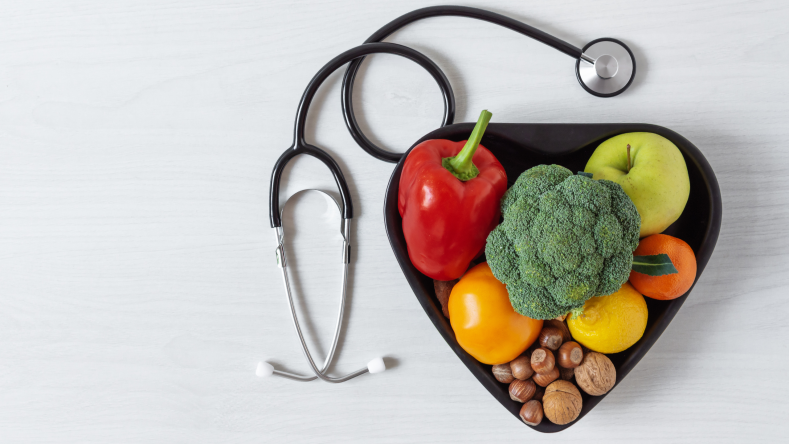Everything you need to know about homocysteine
Homocysteine is an amino acid that works in conjunction with folate, vitamin B12, and vitamin B6 to create other important chemicals. However, high homocysteine levels can spell disaster for your health, and even increase your risk of numerous health conditions. From blood tests to symptoms and dietary sources, here’s everything you need to know about homocysteine.

Homocysteine is an amino acid in the blood, and while vitamin deficiency is the most common cause of high homocysteine levels, the symptoms can be hard to detect. Without treatment, elevated homocysteine increases your risk for numerous health conditions, including dementia, heart disease, and osteoporosis. Here’s everything you need to know about homocysteine, including blood tests, symptoms, dietary sources, and supplementation.
What is homocysteine, and what does it do?
Homocysteine is an amino acid (a building block of protein) found in the blood. It is formed by the breakdown of methionine, an essential amino acid that must be obtained through diet [ 1 2
Vitamin B12, vitamin B6, and vitamin B9 (folate) break down homocysteine to make other amino acids your body needs, including methionine (an essential amino acid) and cysteine (a non-essential amino acid) [ 2 3
What is a homocysteine blood test?
A homocysteine blood test measures the amount of homocysteine in your blood, and may help detect vitamin B12, B6, or folic acid deficiency [ 1 4 1
Homocysteine levels are categorized as follows [ 2
Normal: 5.0-15.0 µmol/L
Moderate hyperhomocysteinemia: 16-30 µmol/L
Intermediate hyperhomocysteinemia: 31-100 µmol/L
Severe hyperhomocysteinemia: >100 µmol/L
If your homocysteine level is >50 µmol/L, excess homocysteine may damage the lining of your arteries, and can increase your risk of heart disease, blood clots, stroke, and heart attack [ 3 4
Do I need a homocysteine test?
You may need a homocysteine test if you have an increased risk for heart disease (through conditions such as obesity, high blood pressure, high cholesterol, diabetes, or genetic predisposition). You may also need a homocysteine blood test if you have symptoms of a vitamin B deficiency, such as [ 3
Weakness
Fatigue
Tingling (like pins and needles) in the hands, arms, legs, or feet
Dizziness
Pale skin
Tongue or mouth sores
Mood changes
If you experience any of these symptoms, your healthcare provider may recommend a homocysteine test.
Homocysteine and methylmalonic acid (MMA) in B12 Deficiency
Vitamin B12 deficiency can be caused by nutritional factors, malabsorption, and other gastrointestinal (GI) causes [ 5
Individuals at greater risk for deficiency include the elderly, strict vegans, alcoholics, people taking certain medications (including proton pump inhibitors, H2 receptor antagonists, and metformin), and those with cancer or certain GI conditions, or who have had certain GI surgeries [ 5
Vitamin B12 deficiency can be challenging to diagnose because B12 levels in the blood can be misleading. In fact, research has shown testing serum B12 levels alone can hide B12 deficiency in up to 50% of patients [ 5
A true B12 deficiency will cause increases in both methylmalonic acid (MMA) and homocysteine, even when serum vitamin B12 concentrations are within the normal range. For this reason, MMA and homocysteine levels are considered better indicators of B12 deficiency than a serum B12 test [ 5

What factors affect homocysteine levels?
With the help of vitamins B6, B12, and folate, homocysteine converts into other amino acids so only a tiny amount remains in your blood. However, certain factors and health conditions can increase your risk for elevated homocysteine levels, including [ 2 3
Older age (homocysteine levels can increase as you get older)
Menopause
Being male (men usually have higher homocysteine levels than women)
Drug and tobacco use
Excessive alcohol consumption
Deficiencies in vitamins B12, B6, or folate
Kidney or thyroid problems
Cancer
Psoriasis
Diabetes
Heart disease
Rare inherited diseases, including homocystinuria
High homocysteine symptoms
High homocysteine levels can be dangerous as excess homocysteine damages the lining of blood vessels that carry oxygen-rich blood throughout your body. Without treatment, elevated homocysteine levels can lead to severe health complications and increase your risk for blood clots, heart attacks, heart disease, stroke, dementia, and osteoporosis [ 3 6
The symptoms commonly associated with high homocysteine levels are typically related to a folate or vitamin B12 deficiency since these are the most common causes of high homocysteine levels [
3
].
Children with homocystinuria may develop symptoms during the first few years of life, although some never do. Some of the more common symptoms in children include [ 16
Slow growth and weight gain
Pale skin and hair
Abnormally-shaped chest
Weak bones
Severe nearsightedness and lens dislocation (which can cause blindness)
Tall, slender build and long, skinny fingers
Blood clots (with increased risk for stroke and heart disease)
Seizures
Developmental delays
Learning disabilities
Behavior and emotional challenges
Risks of high homocysteine
Elevated homocysteine levels can have significant health risks, so here are some common conditions associated with high homocysteine.
Cardiovascular disease.
High homocysteine negatively impacts your heart and blood vessels, as it damages the lining of your arteries, the blood vessels that carry oxygenated blood throughout your body. Levels greater than 50 µmol/L can cause inflammation and constriction of the arteries, increasing your risk of heart disease and heart attacks [ 3 4
High levels of homocysteine may also make the blood clot more easily, increasing the risk of blood vessel blockages and stroke [ 7
Osteoporosis.
High homocysteine puts you at greater risk for osteoporosis, a weakening of the bone that affects nearly 13% of adults and almost 20% of women over age 50 in the US [ 8
Evidence shows elevated homocysteine levels contribute to bone demineralization and turnover, decreased bone blood flow, and low-quality bone mass [ 9 10
In addition to getting enough calcium, vitamin D, protein, and regular exercise, treatment of hyperhomocysteinemia may be an additional therapeutic approach for osteoporosis prevention in the future; however, more research is needed [ 11
Dementia.
It’s estimated that around 5.8 million people in the United States have Alzheimer’s disease and related dementias [ 12
Research shows high homocysteine levels play a significant role in the development of mental declines associated with Alzheimer's disease and related dementias and are considered a risk factor for these diseases in older adults [ 13
A recent systematic review found that those with Alzheimer’s, dementia, or vascular dementia had higher levels of homocysteine and lower folate levels than those without dementia [ 14 15
While there is still no effective therapy for dementia, researchers are exploring ways to slow the progression of Alzheimer’s and related dementias in older adults with cognitive impairment [ 14 14 13
What is the treatment for high homocysteine?
The treatment for high homocysteine caused by a B vitamin deficiency is B vitamin supplementation. Therefore, your healthcare provider may recommend taking supplements of vitamin B6, B12, and folic acid (the supplemental form of folate).
Over-the-counter multivitamins that contain at least 250 μg of folic acid, 2-25 mg of vitamin B6, and 5-100 μg of B12 may help reduce high homocysteine levels, but this may not be sufficient as they contain much lower amounts than individual supplements [ 2 2
Your healthcare provider may recommend rechecking your homocysteine levels after two months and increasing the dosage if they have not normalized.

How to lower high homocysteine levels naturally
Increasing your intake of folic acid and B vitamins from foods may help lower your homocysteine level naturally. Here are some dietary sources to include in your daily routine.
Folate: obtained through fruits, green leafy vegetables, fortified bread and breakfast cereals, lentils, chickpeas, beans, and asparagus.
Vitamin B12: found in sardines, clams (including the broth of boiled clams), tuna, trout, beef, milk, and fortified foods like breakfast cereal and nutritional yeast.
Vitamin B6: present in tuna, beef, fortified cereals, milk, chickpeas, chicken, and eggs.
Summary
Homocysteine is an amino acid in the blood produced by the breakdown of methionine, an essential amino acid found in foods. Vitamins B12, B6, and folate break down homocysteine and create other proteins that the body needs. High homocysteine levels may be caused by a B vitamin deficiency, an underlying condition such as heart disease, or a rare genetic disease called homocystinuria.
Elevated homocysteine levels can increase your risk of cardiovascular disease, blood clots, osteoporosis, Alzheimer’s disease, and related dementias, but can be treated with vitamin B12, vitamin B6, and folate supplements along with subsequent dietary sources.
Disclaimer: The text, images, videos, and other media on this page are provided for informational purposes only and are not intended to treat, diagnose or replace personalized medical care.
Key takeaways
Homocysteine is an amino acid (a building block of protein) found in the blood. It is formed by the breakdown of methionine, an essential amino acid that must be obtained through diet [
1
,2
].A homocysteine blood test measures the amount of homocysteine in your blood, and may help detect vitamin B12, B6, or folic acid deficiency [
1
,4
].You may need a homocysteine test if you have an increased risk for heart disease or have symptoms of a vitamin B deficiency.
High homocysteine levels put you at greater risk for cardiovascular disease (including heart disease, heart attack, and stroke), blood clots, osteoporosis, and Alzheimer’s disease.
The most common cause of high homocysteine levels is vitamin B6, B12, or folate deficiency and can be treated with B vitamin supplementation.
Increasing your intake of folic acid and B vitamins from foods may help lower your homocysteine level naturally.
References:
Ganguly, P., & Alam, S. F. (2015). Role of homocysteine in the development of cardiovascular disease. Nutrition Journal, 14(1).
https://doi.org/10.1186/1475-2891-14-6
Varga, E. A., Sturm, A. C., Misita, C. P., & Moll, S. (2005). Homocysteine and MTHFR Mutations. Circulation, 111(19).
https://doi.org/10.1161/01.cir.0000165142.37711.e7
Homocysteine: Levels, Tests, High Homocysteine Levels. (2018, December 2). Cleveland Clinic. Retrieved June 8, 2022, from
https://my.clevelandclinic.org/health/articles/21527-homocysteine
Homocysteine Test. (2020, December 3). Medline Plus (National Institutes of Health). Retrieved June 3, 2022, from
https://medlineplus.gov/lab-tests/homocysteine-test/
Vashi, P., Edwin, P., Popiel, B., Lammersfeld, C., & Gupta, D. (2016). Methylmalonic Acid and Homocysteine as Indicators of Vitamin B-12 Deficiency in Cancer. PloS one, 11(1), e0147843.
https://doi.org/10.1371/journal.pone.0147843
Heart Disease and Homocysteine. (2007, January 1). WebMD. Retrieved June 3, 2022, from
https://www.webmd.com/heart-disease/guide/homocysteine-risk
Familydoctor.org editorial staff. (2020, May 4). High Homocysteine Level: How It Affects Your Blood Vessels. Familydoctor.Org. Retrieved June 9, 2022, from
https://familydoctor.org/high-homocysteine-level-how-it-affects-your-blood-vessels/
Sarafrazi N, Wambogo EA, Shepherd JA. Osteoporosis or low bone mass in older adults: United States, 2017–2018. NCHS Data Brief, no 405. Hyattsville, MD: National Center for Health Statistics. 2021. DOI:
https://dx.doi.org/10.15620/cdc:103477
Behera, J., Bala, J., Nuru, M., Tyagi, S. C., & Tyagi, N. (2017). Homocysteine as a Pathological Biomarker for Bone Disease. Journal of cellular physiology, 232(10), 2704–2709.
https://doi.org/10.1002/jcp.25693
van Meurs, J. B., Dhonukshe-Rutten, R. A., Pluijm, S. M., van der Klift, M., de Jonge, R., Lindemans, J., de Groot, L. C., Hofman, A., Witteman, J. C., van Leeuwen, J. P., Breteler, M. M., Lips, P., Pols, H. A., & Uitterlinden, A. G. (2004). Homocysteine levels and the risk of osteoporotic fracture. The New England journal of medicine, 350(20), 2033–2041.
https://doi.org/10.1056/NEJMoa032546
de Martinis, M., Sirufo, M. M., Nocelli, C., Fontanella, L., & Ginaldi, L. (2020). Hyperhomocysteinemia is Associated with Inflammation, Bone Resorption, Vitamin B12 and Folate Deficiency and MTHFR C677T Polymorphism in Postmenopausal Women with Decreased Bone Mineral Density. International Journal of Environmental Research and Public Health, 17(12), 4260.
https://doi.org/10.3390/ijerph17124260
The Truth About Aging and Dementia | CDC. (2019, August 20). Centers for Disease Control and Prevention. Retrieved June 9, 2022, from
https://www.cdc.gov/aging/publications/features/Alz-Greater-Risk.html/
Smith, A. D., Refsum, H., Bottiglieri, T., Fenech, M., Hooshmand, B., McCaddon, A., Miller, J. W., Rosenberg, I. H., & Obeid, R. (2018). Homocysteine and Dementia: An International Consensus Statement. Journal of Alzheimer's disease: JAD, 62(2), 561–570.
https://doi.org/10.3233/JAD-171042
Wang, Q., Zhao, J., Chang, H., Liu, X., & Zhu, R. (2021). Homocysteine and Folic Acid: Risk Factors for Alzheimer’s Disease—An Updated Meta-Analysis. Frontiers in Aging Neuroscience, 13.
https://doi.org/10.3389/fnagi.2021.665114
Seshadri, S., Beiser, A., Selhub, J., Jacques, P. F., Rosenberg, I. H., D’Agostino, R. B., Wilson, P. W., & Wolf, P. A. (2002). Plasma Homocysteine as a Risk Factor for Dementia and Alzheimer’s Disease. New England Journal of Medicine, 346(7), 476–483.
https://doi.org/10.1056/nejmoa011613
What Is Homocystinuria? (2017, April 6). WebMD. Retrieved June 9, 2022, from
https://www.webmd.com/children/what-is-homocystinuria
